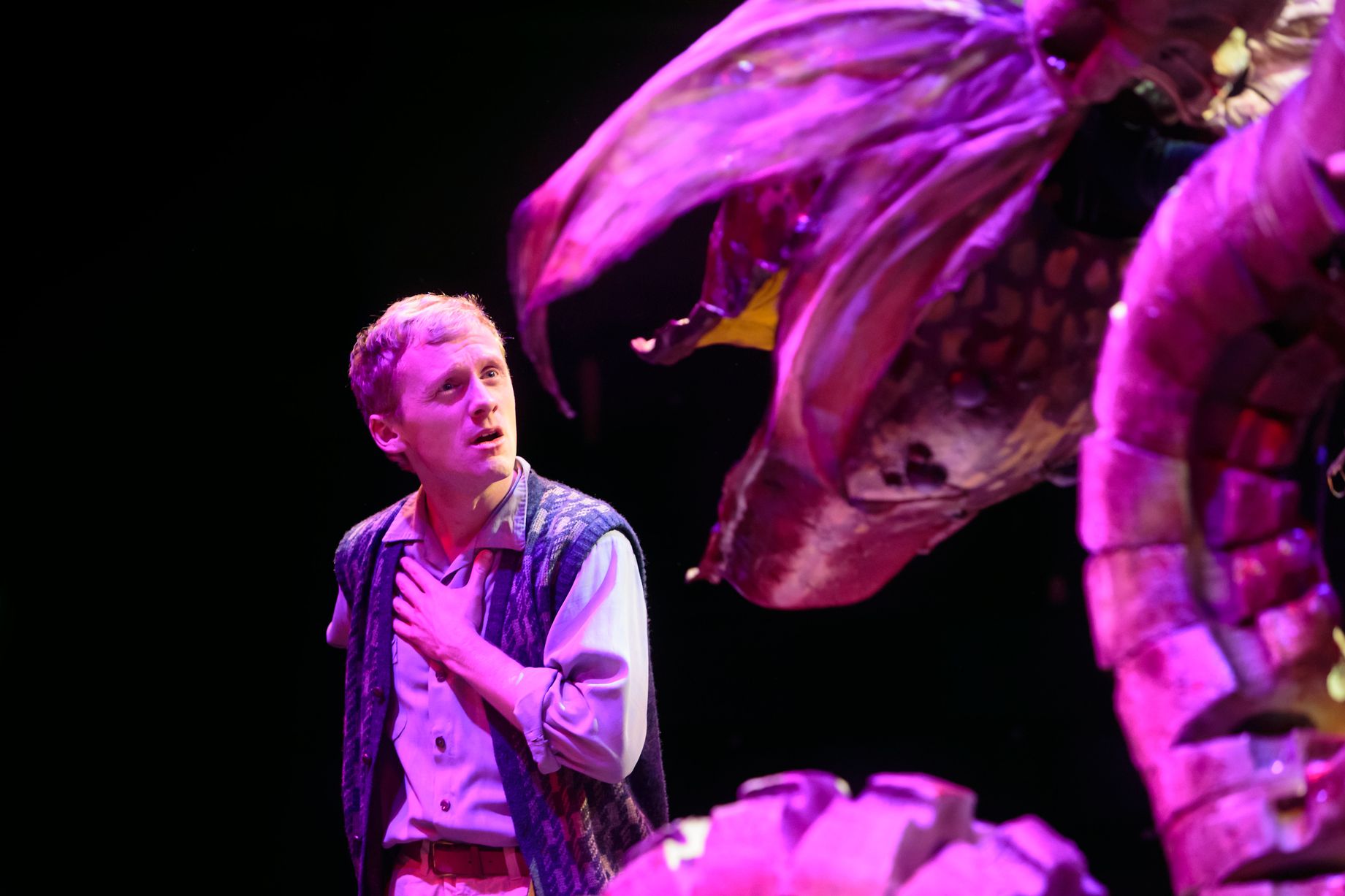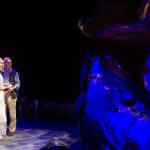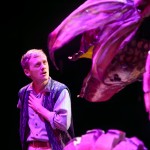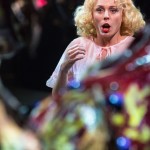A revival of Little Shop of Horrors went down a storm at Manchester’s iconic Royal Exchange Theatre, but then it was chosen for precisely that reason – to be a crowd pleaser and, particularly as a musical comedy, a welcome interlude from the more serious items on the Exchange season. Oh, and in spite of the title not remotely scary nor especially gory!
Bearing in mind that the last time I was at the Exchange I saw Billy Liar as a similarly light and fluffy fantasy interlude, albeit one with darker nods to the working class culture of the industrial north, does suggest that the artistic directors are having to include bums on seats as a key criterion in selecting plays, which the more populist among critics would consider to be no bad thing.
This piece has an interesting and varied history, having started out in 1960 as a black comedy for the big screen, directed tongue-in-cheek by none other than Roger Corman, the king of the 60s horror b-pic. It was only ever intended as schlock-horror, making this an ideal vehicle to spawn spoofs and, in this case, a musical.
This it then happened that the story was written as a hit off-off-Broadway 1982 stage musical with retro pastiche and slightly cheesy 60s-style songs by Alan Menken and Howard Ashman, before touring the world. The stage version was then in turn filmed in 1986 by Frank Oz as a star vehicle for the likes of Rick Moranis, Ellen Greene, Levi Stubbs (of whom more anon) and, most famously of all, Steve Martin (not to mention cameos by the likes of James Belushi, Bill Murray, Christopher Guest and John Candy for those who like to count the A-to-C-listers.) This version was indeed a smash hit, albeit with a rewritten ending from that devised for the stage version, since movie audiences are evidently shallow and always want a happy ending. Such is life.
Director Derek Bond has taken the stage version and adapted it for theatre in the round. For some productions this is indeed a challenge; in this case the furniture and the mutant talking man-eating alien plant are on wheels to enable them to apply mobility and scoot around the stage for the benefit of all members of the audience. In fact, this works a treat, if you can visualise the Skid Row of the song, complete with gutters, forming a perfect circle around the stage.
The perimeter space is the domain of the modern equivalent of the Greek chorus, artfully named Crystal, Chiffon and Ronnette – though you might also call them backing singers. The strut their stuff, chip in to provide context and moral advice to the characters, and lead some of the songs with the help of strong soulful voices – the voices being those of Ellena Vincent, Ibinabo Jack, and Joelle Moses. Perhaps they are overdressed by comparison with real life bum-ettes on Skid Row, but they rightly create a stir.
In this unsalubrious downtown location lies Mushnik’s floristry store, fast heading for bankruptcy as Mushnik (Sevan Stephan) finds nobody wants to buy his flowers. About to lose their jobs are his two employees: diffident, down at heel nerdy dreamer Seymour (Gunnar Cauthery, who appeared in the Spielberg movie of War Horse) and his heart’s desire, Audrey (Kelly Price, a National Theatre actress.)
Seymour is nurturing both a love for Audrey, frustrated by her sadistic dentist boyfriend (Ako Mitchell, who turns up in a variety of minor comic roles to great effect and charms the socks off the audience each time) and a strange wilting plant, something akin to a Venus flytrap and which apparently thrives on his blood. Named Audrey II, the plant steadily grows as part of its mission to take over the world, though in this production it finds its niche at around 6 feet, fully extended (though by the end Audrey has outgrown the theatre.
This was always going to be the challenge for a stage production, since animatronic plants are generally beyond the budget of theatres. Rather than hiding the gubbins and the operators, Bond has chosen to have the puppeteer(s) of the various incarnations of Audrey II in full public view. As it turns out, this was a wise choice – one that works really perhaps better than you had any right to expect, particularly when the chief Viridiplantae kineticist (for want of a better phrase) is also voicing Audrey.
You will recall that in the second movie, the plant was voiced by Levi Stubbs (of Four Tops fame) giving he/she/it a truly larger than life urban black sound – and all the better for it as the plant growls “Feed me, Seymour, FEED ME!” In this instance, the manipulation and vocal pyrotechnics are down to dancer and singer Nuno Silva, who darn near pulls off Stubbs to a tee – white man, black voice! No question about it, Silva/Audrey II steal the show between them, whatever other talents are on display. It’s a direct mimic with the lithe and nimble choreography you could only deliver with a professional dancer – but for all the direct human intervention this is a plant you can believe in, every bit as much a character as the rest of the cast.
This is not to say there is anything wrong with the other actors, far from it. To a man and woman they do a splendid job and, unusually, each can sing well too. Perhaps the least expected instance is Mr Mushnik, who in one number holds a note for what I conservatively estimate to be 15 bars. Try that with most actors-who-do-a-bit-of-singing and you’d get mangled notes splattered over the very grand ceiling of the Royal Exchange building. Congratulations to Mushnik’s alter ego, Mr Stephan for holding it in key to the last, and fully deserving his round of applause!
In fact, such was the entertainment that by the end (which was not over-long) the audience was singing and dancing along with the cast. A bit trickier when you have a theatre in the round with two hanging levels, but I can recall a similar response in a conventional auditorium with the stage version of Return To The Forbidden Planet, to name but one. It’s not the greatest show you’ll ever see, and highbrow it most certainly is not – but it is good fun and all the better for letting its hair down and revels in its own kitsch spoofdom. But there has to be a star, and as Jane Shilling puts it in The Telegraph:
“The piece de resistance is Audrey II herself, who grows steadily from something resembling a delinquent amaryllis to a mouthy, outsized, tentacular monster.”
LSoH is splendid fun and light entertainment! Maybe the songs are not the best you’ll find in a musical but it does its job. What more could you possibly want than that?










